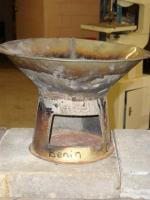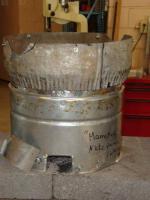Christa Roth and Christoph Messinger, August 2010
Improved Charcoal Stove
Improving the Charcoal Stove for Haiti, Stove Camp 2010 (see the Stove Camp Summary for challenge details)
Main points mentioned at the end of the Stove Camp Workshop
- We need a high turn down ratio.
To bring water and foods fast to the boil, we need high power in the heat-up phase.
However, thereafter we commonly need low power for simmering. The stove
therefore needs to offer the opportunity to turn down the power output drastically.
Options:- Regulation of primary air supply (e.g. closing door)
- The gap between pot and charcoal is increasing over cooking time (shape of char container provides more depth = increased gap to the char)
- c) The amount of char available at the end of cooking is reducing (conical shape of char container = less char over time available)
- We need to reduce heat losses to the bottom and to the side of the stove.
A char container radiates heat to all sides – not just to the pot. To reduce the amount
of char used, it is important to reduce the heat losses to the other directions.
Options:- Bottom of stove: rebounding plate (with holes) in between primary air supply
- intake and charcoal container. Thus primary air is channeled through the
- heated rebounding plate, taking some heat back into the char container.
- Side of the stove: double wall with air in between for insulation.
- We need to maximize heat harvest from a given amount of charcoal.
Charcoal burning is mainly influenced by the amount of air available in the char
container.
Options:- A vertical spacer in the center of the charcoal container (Lanny Henson’s pig tail”) seemed to increase the availability of air for charcoal combustion.
- Additional draft (e.g. forced air) may increase heat generation per time unit. However, this may also increase CO emissions and reduce efficiency of char use.
- Secondary air to burn off the CO in a gap between the charcoal and the pot may provide additional heat. However, for this to be beneficial it may not impact on the surface area available for direct radiation from the charcoal to the pot and should not cool down the air in the gap (well preheated secondary air).
- We need to maximise heat transfer to the pot.
Generating as much heat as possible out of a given amount of charcoal is one step.
But another important step is to make sure that most of this heat actually is
transferred into the cooking pot.
Options:- “Sunken pot” concept seems to provide best results in terms of heat transfer (Henson stove). Unfortunately, in real life this might not be possible in many work environments.
- Best heat transfer is NOT achieved if the pot rests on the char. Optimum is about 1inch away from the char, not closer than that. For Simmer, this could increase to 2-3 inches.
- A skirt is highly important to shield the gap area between the pot and the char against the influence of wind. The gap between pot and skirt should bedetermined.
Christa’s Summary of the stove camp
| Observation and necessary action | Derived Design Principles |
|---|---|
| Charcoal radiates heat to all sides: as much can radiate towards the bottom of the stoves as can radiate upwards towards the pot. Action: |
|
| Charcoal combusts in function of the available oxygen. Thus heat generation is a function of air supply to the charcoal grate. Action: get the right amount of air to the charcoal grate. To little will choke the combustion, too much will cool the flue gases. |
If power of the stove is too low, increase air supply by
Do not pile the charcoal up too high, as this will restrict air flow through the charcoal bed (this is influenced as well by the shape and particle size of the charcoal chunks). |
| The combustion of charcoal goes from oxidizing C to CO, then in a subsequent step from CO to CO2. CO is a toxic gas and has still considerable energy value. Ensuring a complete combustion |
|
|
Charcoal radiates heat but there is also considerable convection of hot flue gases. Action: Optimize transfer of created heat into the pot. |
Avoid obstructions between the radiating charcoal bed and the bottom of the pot (increase the view factor of the charcoal seeing the pot). |
Test running, chaussures, montres cardio gps et habits sports


